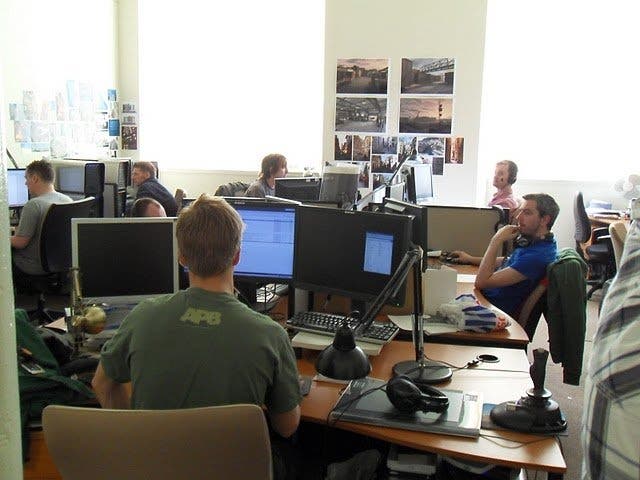What happened to gaming's Waterworld?
The fall and plummet of APB.
Back in 2008, Realtime Worlds was sitting pretty. A year after the release of the well-received Crackdown, the Dundee-based studio's founder and GTA creator David Jones managed to net $50m for its pet project, the ambitious MMO APB: All Points Bulletin. He was positive about its chances, and given the interest in the project and the pedigree behind it he had every right to be. APB would be the company's first big online game, he thought. Instead, it was to be Realtime Worlds' last.
Three months after APB's much-delayed launch in September 2010 Realtime Worlds announced it would be closing down, and taking the APB servers down with it. After five years of development and having cost the company just shy of $110 million, APB was open for just 86 days.
So how did a game in which some of the brightest developers in Scotland poured their skills and dreams come to deliver a deathblow to an esteemed company? Video games had found their Waterworld, but how had APB managed to turn into such a disaster?
Nicoll Hunt came on board APB 18 months into its development in 2006, originally working as a graphics programmer on the game's extensive customisation system. Over his four years with Realtime Worlds his role progressed until he was the lead UI programmer. In those early days, all the signs were good, and the company was striving to do everything right.

"APB was one of the most ambitious games that I've worked on and I'd heard of anyone working on," Hunt recalls. The reason he joined the team was because this was a developer set on doing things the right way. APB was going to be rigorously concepted, all the design work being carried out on paper before any coding would be done. The problem was, once APB left the drawing board, many of its big ideas just didn't work. Key concepts fell totally flat, leading to a long process of redesigning and recoding.
For a company the size of Realtime Worlds at the time of APB, all that extra time spent in development would cost a lot of money. With all the investment placed in the project Realtime Worlds had more than enough funds - the problem was they weren't being managed all that well.
One comment, posted by someone claiming to be an ex-staffer on a Rock,Paper,Shotgun story about redundancies at the company, suggested directionless creative leadership was largely at fault: "The sheer time spent and money it took to make APB is really a product of fairly directionless creative leadership" said the commenter, ExRTW, "Certainly Dave J (David Jones) has great, strong, ambitious ideas for his games. But he's a big believer in letting the details emerge along the way, rather than being planned out beyond even a rudimentary form. For most of the lifetime of APB, he was also CEO of the whole company, as well as Creative Director." ExRTW continued. "His full attention was not there until late in the day."
It's key to point out that it wasn't for lack of talent or lack of structure that APB did poorly: "The company tried so hard to do things well and treat the employees well. The bosses were brilliant. All my co-workers were top of their field, super super intelligent guys" says Hunt, adding it was the only company he'd ever worked at where he'd received paid overtime, a far cry from the horror stories of crunch that emerge from other studios.
For most Realtime Worlds staffers I spoke to (both on and off the record) it seemed that what APB struggled with most was its own identity. "It didn't know what kind of a game it wanted to be" said Hunt, "Did it want to be something like World of WarCraft? A shooter with an open environment? A more arcadey experience like Grand Theft Auto where you jump in with your friends and cruise around the streets in your cars?" As development continued, more and more ideas were being jammed into the game, and not every aspect was equally polished.

Ben Bateman joined Realtime Worlds towards the end of the project in QA, but eventually moved to the company's community team. As creative officer at Realtime Worlds, he was the public face of the company and the one responsible for announcing APB's closure: "I think that it was trying to do too much in certain areas rather than focus on the core stuff. The customisation engine was phenomenal for its time, it was fantastic, but you've got to think, is it really worth putting all the time and money into that one feature when you can't even get driving right? They had so many issues with the latency, performance as well, and I think people kind of just never took the opportunity to buckle down and say, 'Okay, here's the things we really need to focus on now.'"
As the game got towards the end of development, many staff started to have concerns. David Jones' almost messianic quality meant people were ignoring them, convinced the man behind Lemmings, GTA and Realtime Worlds' previous hit Crackdown had everything in hand. Unfortunately, in lieu of a solid development schedule, vision for the future of the MMO and a tight control on budget, the senior management had hubris that would prove catastrophic.
"In the last three months or so, we finally had all of the systems in and working," says Hunt. "At that point we could start to balance it and make it fun, but at that point we'd also run out of money and the game had to come out on a specific day, so everything was being ignored, like horrible game-breaking bugs on release."
"Everyone internally knew what was wrong and how to fix it, but we just didn't have the time left."
The first suggestion to many that things might really be in trouble came a couple of months before APB's final release date. Something odd was happening: the cleaners were being made redundant. Weeks later, contractors at the company started to have their contracts terminated early. Management suggested everything was fine at the company, both internally and to press, but within the Dundee office people were starting to fear for their jobs.
After being released to beta testers, initial feedback pointed out a number of issues: unresponsive weapons, poor car handling, no headshots, poor performance on high end machines and a catastrophic problem with lag were all tagged as issues. Those in the company remained optimistic. It was a beta, and Bateman was there to assure the community that their problems would be addressed.
As with the improvements Nicoll Hunt wanted, there just wasn't enough money left to fix the problems. Many of these early issues persisted from the early days until the game launched.
So, while APB was riddled with bugs and had to face the long road of patches to balance and polish it, the marketing was hyping it up as the game of the generation, through marketing schemes both good and bad: "We paid £35,000 to customise a truck which would then go to truck shows and events while they were in the country," says Hunt, "the theory was that if we had the APB livery all over it, it would be a way of promoting the game. I'm not quite sure where the overlap between people who go to truck shows and people who buy large-scale MMOs is."
Another big marketing scheme was the human avatar project, where players could reenact the game's customisation system on a real human. In reality, this involved giving a freerunner from south London a haircut, septum piercing and dodgy tattoo. It certainly succeeded in getting press for the game.
Unfortunately, feedback from the open beta and news that the game's review embargo was set for 10 days after APB's launch were doing a good job of negating any hype the marketing might have gathered. Internally, staff weren't keen on the release. ExRTW said: "I was genuinely shocked when I played the release candidate - I couldn't believe Dave J would be willing to release this. All the issues that had driven me nuts about it were still there - the driving was poor (server-authoritative with no apparent client prediction, ergo horrendously lag intolerant), combat impact-less, and I found the performance of the game sub-par on what was a high-spec dev machine."
While the press were banned from releasing their opinions on APB, players weren't. The relatively recent appearance of microblogging site Twitter and the ability to comment on the website of your favourite gaming site meant that bad news spread far and fast. Critical reviews weren't as savage as you might expect but it wasn't selling anywhere near what it needed to be. Instead of a WoW killer, APB was scraping along the bottom of the PC only chart, not ideal for a AAA title looking to find an audience.
Most of the criticisms surrounding APB were that it wasn't fun. Much like the problems identified during development, players weren't sure what to make of the game. By 2010, World of Warcraft was approaching 12 million subscribers, and APB wasn't anywhere near it in terms of content. It was a worse team based shooter than many of those currently on the market and the only thing that was really capturing people's attention was the character creation.
"There were some really good positive signs in the last, like, two or three months," said Bateman "There were changes within the team and what people were thinking about. The next patch was gonna fix loads of stuff, like the driving and some shooting mechanics."
"Within the studio they'd been sharing a top-level kind of roadmap ideas of 'Where should we take APB next?', because it didn't have necessarily the deep mechanics it needed. There were some really great ideas that just never happened."
Some team members took it upon themselves to mock up some of the changes they wanted to make in the hope of bettering the game. Now that the game was out, it was time to polish it up and help it find its audience. This video, posted to Youtube after the studio's downfall, uses a mix of internal game footage and post processing tools to show some of the potential changes that could give the game a bit more impact. It's a great tool for showing both how lifeless the game was at release, but also how easily the game could be polished up.
"The combat mechanics were an aspect that had received a good deal of criticism but had not seen much improvement," said James McWilliams, a former Realtime Worlds employee and the creator of the videos. "Although I had been brought onto APB to fill the lead UI Artist role - I began creating the proposal videos in my own time in order to suggest tweaks."
"They went down well so I got asked to do more. In retrospect I probably overcooked some of it (like the camera shake) but I just wanted to show the stark contrast and how the feel could be changed to make combat less stale."
Unfortunately, the lack of sales and the expensive production schedule meant that there still wasn't enough money to develop anything new, and what's worse, there wasn't enough money left to pay the studio's creditors, or in many cases, Realtime Worlds' staff. The glittering jewel at the heart of Dundee's game development scene was finished, and administrators moved in in the middle of August 2015. 60 people were laid off immediately, and while they didn't yet know it, everyone employed at the company would be gone in less than a month. Many of them left with just two day's pay instead of the holiday time accrued and time worked.
Staff reactions were mixed. A blogpost from Realtime Worlds staffer Luke Halliwell offers a fairly restrained comment on the state of things at Realtime Worlds as it shuddered to a close: "There had been mounting discontent internally about the competence of our top management - and what better proof could you need than this. How they could keep operating the company when they couldn't even pay this month's wages, I don't know. Presumably they continued to think we had a chance somehow; the behaviour of a deluded, greedy, addicted gambler."
Halliwell's wife Lucy is less restrained: "Dave Jones and Ian Hetherington have pissed away millions, they are getting away with not paying over 200 employees for the work that they have done and have fiddled their way to being able to buy back Project:MyWorld for cheap. Moreover these very people have enough personal wealth to pay the money owed to the individuals and families whose lives they have left shattered, heck Dave could probably pay them all just by selling one of his beloved cars. So I'm more than a little pissed off, but mothers get like that when their kids are hurting."
"When we got told that we were in administration," said Bateman, "Dave Jones was going round and apologising to everyone, which I think says a lot about him as a person. Maybe, you know, as a CEO he wasn't so great, but as a person he was a really nice guy."
APB went down with Realtime Worlds after the servers being open for short of three months. All of the ambition, talent and hard work from a team of people that've gone on to work in nearly every corner of the industry was gone. It was a game of, by all accounts, completely unchecked ambition. What other shooter would let you compose a short piece of music, in game, and then play that little jingle to people after you shot them in the head? APB was a unique oddity, that sadly delivered too little too late.
While lots of parts from APB's legacy have been cannibalised, and you can certainly see elements of it in Rockstar's own GTA Online, Bateman suggests the biggest part of APB's legacy is its collapse. "You don't see that same level of failure. Of course companies go into administration all the time and projects get canned, but it's less a case now of people investing $100 million into a game and then it crashing quite so massively."
APB limps on, returning most recently via GamersFirst as APB Reloaded, a free to play shooter that made improvements in some areas and several steps back in others. The Xbox One version that launched earlier this year has the less than desirable reputation of being the worst game to have graced Microsoft's console."This is basically where the game was peak awful," said Hunt after playing it. "That's the game they've released on Xbox One."
There was a lot that wasn't perfect about APB, but it deserves to be memorialised better than the zombie state its successor is currently in. For all the trouble and heartbreak around the development of the original, Bateman describes seeing footage of the Xbox One version as the only difficult thing about working on APB. "It's not like a stab in the back, but I swear, you know, the game we had - it was better than that."




